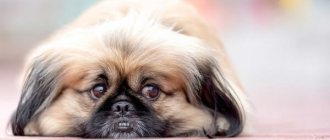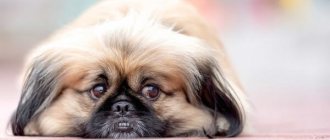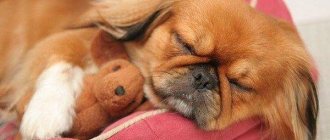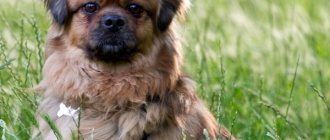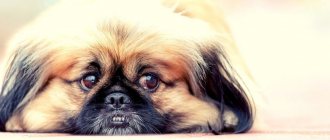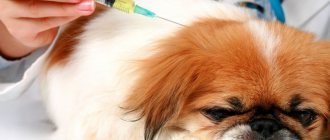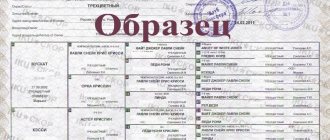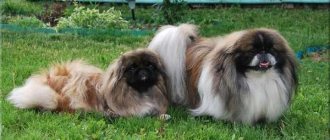History of the breed
The Pekingese is a companion dog. It was developed in ancient China at least 2000 years ago. Some scientists believe that this breed existed as early as 5000 BC. The happy owner of the Pekingese was exclusively the emperor. Ordinary people could not even look at the miracle animal, because it never left the imperial chambers. Courtiers who dared to touch the Pekingese to pet him lost their hands. And attempting to take an animal outside the palace was punishable by death. It was only in 1860 that Europeans first saw miniature lion-like dogs and were able to take five animals from the Imperial Palace.
There are many legends about the Pekingese. Here is one of them.
The emperor issued a decree to exterminate all fire-breathing dragons, as they often raided human settlements and burned everything in their path.
One dragon at that time was about to give birth to a long-awaited offspring. He asked the god of the mountains for protection. He took pity and replied: “I will make your children cute and fluffy. All women and children will be delighted with them. However, you must promise that you will never teach them to breathe fire.” The dragon promised.
Some time passed and he gave birth to cute and fluffy cubs. They had long faces, but they did not know how to breathe fire. The dragon father could not resist and showed them his art. When the cubs tried to release the flame, their furry faces caught fire. The babies' eyes opened wide and increased in size. The fire smoldered until the faces became flat and black. This is how the Pekingese appeared.
Description of the breed
According to another of the many legends, the Pekingese descended from a lion and a monkey, so its appearance and character have features from both of its “parents.”
They have a sense of dignity and will not tolerate familiarity. At the same time, the Pekingese remains a cute and cheerful creature. Dogs of this breed are small in size and were bred solely for decoration. That is why you can find a huge variety of colors - gray, red, fawn, black and snow-white. Chinese emperors loved bright colors and often wore dogs to match their outfits. White color in China was considered a symbol of death, so white colors were very rare.
Appearance
Let's start describing the Pekingese with its appearance. This exoticism is probably its main advantage. An adult Pekingese (photo below) is a small decorative dog with long hair reminiscent of a lion's mane. The following appearance parameters are defined for dogs of this breed. The size of the Pekingese is represented by its height at the withers, and the weight of an adult Pekingese is given without taking into account gender.
- An adult dog has a height at the withers from 15 to 25 cm;
- Weight ranges from 3.2 to 5.6 kg.
It is necessary to say a few words about the main wealth of the Pekingese - their wool.
- The color can be any, but there must be black spots around the eyes and on the tips of the ears;
- The coat is straight and rather long, the undercoat is thick and soft;
- The hair on the head resembles the shape of a lion's mane, and at the tip of the tail it looks like an open flower.
Other parameters are similar to many other breeds.
- The physique is quite strong and muscular;
- These dogs have a large head. The Pekingese skull is wide, flat and in no case round or apple-shaped;
- The muzzle is snub-nosed and slightly flattened, in accordance with the shape of the skull;
- The ears are hanging, covered with long soft hair, similar in shape to poplar leaves;
- The eyes are dark brown, round, slightly bulging;
- Despite its funny appearance, the Pekingese's teeth are small, but strong and sharp, as befits a dog.
Lifespan
It's probably time to answer the question - how many years do Pekingese live? From different sources we will receive different and sometimes contradictory data. By comparison, I derived a certain arithmetic average number of years of their life, which was confirmed by the dog owners.
However, this is not a dogma and much depends on you, or rather on the care you provide for your pet. So if you are asked how long Pekingese live on average, you can safely answer that with good, proper care, they can live 17 or even 18 years.
Interesting photos of Pekingese
Look at a selection of interesting and funny photos. On them you can clearly see what a Pekingese dog looks like.
Character
Despite its cute appearance, the Pekingese has a complex character, different from many other decorative long-haired breeds. Dogs of this breed require increased attention from the owner. They love order very much. Pekingese do not tolerate haste and fuss; it is advisable for their owners to follow a once-established daily routine for their pet.
Characteristics of the Pekingese breed
Pekingese have fairly long hair, which is much thicker and longer around the neck and head than on the rest of the body. Regardless of color, Pekingese most often have black hair on their faces, around their eyes, and on the tips of their ears.
Dogs of this breed are found in different colors:
- red - golden, light red, dark red, red;
- fawn - from milky to dark nut;
- gray - gray, gray-fawn;
- black;
- white;
- cream;
- black and white;
- white and red (paticolor);
- black and tan;
- murugi color.
Liver colors are also available. Such dogs are considered a defect in the breed. Dog breeders also refuse albinos.
Characteristic features of the Pekingese:
- small but strong body;
- large and wide head;
- large and bulging eyes;
- flat muzzle;
- length of ears to lower jaw;
- the front legs are shorter than the hind legs.
Breed standard
There are breed standards that are accepted in each country that breeds Pekingese, and international ones accordingly. They all have a similar description of the dog's appearance and character.
What does a Pekingese look like: breed standard
- The Pekingese measures 15–25 cm and weighs no more than 5.5 kg. Most often, Pekingese males weigh 0.5 kg less.
- stature , has a stocky build, powerful paws, large round eyes and a thick mane.
- Head : flat skull, wide forehead, massive muzzle. All representatives of the breed have a horizontal fold on the bridge of their nose.
- The nose is in line with the eyes - it is black, flattened, with wide, raised nostrils.
- The jaw of these dogs is wide, especially the lower one. The teeth are white and even, small in size.
- The lips have black pigment. The upper lip is dense and adjacent to the lower lip. The dog's profile should ideally be almost flat.
- The eyes are brown, round, and widely spaced. The darker the eye color, the better. There is a black rim around the eyes and they are in line with the nose.
Important! The eyes should not be too bulging, as goggle-eyedness is already a disqualifying factor in competitions.
- ears are drooping, heart-shaped, and fit tightly to the head. Their fur is long and has a fringe on the tips and outside. In a purebred dog, the ear does not hang below the fangs.
- The neck is strong, short, massive.
- The body may be elongated or pear-shaped, but it always tapers from the chest to the croup.
- chest is wide and its ribs are prominent. The shoulder blades fit tightly to the back. The waist is clearly visible.
- The back is straight, with noticeable muscles. The withers blend smoothly into the line of the upper body.
- limbs are large. The forearms are curved, but should be level, and the elbows should not be pointed out or in.
- Paws are massive, with hair between the pads. The hind ones are more graceful than the front ones, but also well developed. The dog's movements are active and confident.
- tail cannot be docked; it should always be in a fluffy state.
- The coat is hard, long, and the undercoat is short and dense. The mane is shaped like a frill and falls over the neck and shoulders. Show dogs are not cut like lions; their fur is simply trimmed and given the correct haircut.
- Pekingese colors If the coat is spotted, then the spots are evenly spaced.
If we compare the Pekingese with other breeds, we note the greatest similarity with the Japanese Chin.
Advice! Choose your pets from breeders carefully. For example, the Pekingese always has a thick undercoat, while the Chin has a thin undercoat. The color of the Chin is white with spots, and the Pekingese is rarely white, most often it is of cream, reddish shades.
These breeds have limbs of different massiveness . The Japanese Chin is thin-boned, while the Pekingese has massive oval paws. Pekingese have round eyes, while Chins have almond-shaped eyes.
Both breeds have a flattened muzzle. It is worth paying special attention to the paws - stocky, short, massive paws are characteristic of the Chinese dog.
Breed standard: main characteristics
By familiarizing yourself with the standard features of the Pekingese, you will minimize the risk of purchasing a non-purebred dog or mongrel. That is why it is very important to be savvy in this matter in advance.
Size
In addition to the standard representatives of this breed, there are pocket Pekingese, or large individuals, designed for performances in various show programs. On average, the height of the withers can vary from 15 to 25 cm.
Adult dog weight:
- female - from 3.2 to 5.4 kg;
- male - from 3 to 5 kg;
- There are “pocket” options weighing about 2.7 kg.
Lifespan
With decent care and timely treatment, Pekingese dogs live a long time - about 13-15 years. The quality of life of a pet is directly affected by the presence of vaccinations, products used in feeding, and proper care.
Official website of the FCI. Translation by Evgenia Safonovskaya.
A breed standard is a description of the ideal dog of a given breed; it provides a brief description of the general appearance, type of build, size, and temperament. The standard consistently sets out a description of the animal's features from head to tail, as well as the characteristics of its coat and color. The Russian Cynological Federation (RKF) uses standards approved by the International Cynological Federation (FCI).
USE: Companion.
FCI CLASSIFICATION: Group 9 Companion and Toy Dogs Section 8 Japanese Chin and Pekingese Without working test
GENERAL APPEARANCE: Leonine in appearance with an aristocratic and intellectual expression. Small, well balanced, compact, noble, with self-esteem. Any signs of breathing problems under normal conditions are unacceptable and should be punished.
BEHAVIOR AND CHARACTER: Fearless, loyal, somewhat aloof, but not timid or aggressive.
HEAD: Large, proportionately wider than deep.
CRANIAL REGION: Skull: Wide and flat between the ears; not domed; wide between the eyes.
Transition from forehead to muzzle: Pronounced.
FACIAL REGION: The profile is flat, with the nose located exactly between the eyes. Black pigment is required on the nose, lips and eye rims.
Nose: Short and wide, nostrils large and open. The fold, either continuous or broken, should extend from the cheeks to the bridge of the nose in the shape of a wide inverted “v”. Should not cover your eyes or nose. Narrowed nostrils and a heavy nose crease are unacceptable and should be punished.
Muzzle: Broad, with a firm lower jaw.
Mouth: upper and lower lips at the same level, tongue or teeth should not be visible, a strong lower jaw is required.
Eyes: Large, clear, round, dark and brilliant. No obvious eye problems.
Ears: heart-shaped, at the level of the top line of the skull, close to the head, length not lower than the line of the mouth. The decorative hair is long and abundant.
NECK: Short and thick.
BODY: Short, heavier in front than in back, with a pronounced waist. Topline: Flat. Chest: Broad, with well sprung ribs, let down between the forelegs.
TAIL: Set high, close-lying, slightly curved at the last part to the right or left side. Long decorative coat.
LIMBS:
FOREQUARTERS: Short, thick, with massive bones. The bones of the forearm are curved. The shoulders are quite sloping, look back, and do not stand out. Elbows pressed to the body.
HINDQUARTERS: The hind legs are lighter than the forelegs, with moderate angulation. Stable hock joints. When viewed from behind, the legs are moderately close and parallel. The absolute correctness of the structure is very important.
From the book by L. Kovadlo and E. Kudryavtseva
FEET: Large and flat, not round. The dog stands firmly on its paws, not on its pasterns. The front legs are slightly turned outward. The hind legs point straight ahead.
GAIT/MOVEMENT: Slow, proud, rolling gait from the front. Typical movements should not be confused with swaying, which is caused by weak (loose) shoulders. The hind legs move close and parallel to each other. The correct structure of the front and hind limbs and the correct movements are very important.
COAT:
COAT: Long, straight, with a rich mane extending past the shoulders, forming a collar around the neck; The outer coat is coarse, with a thick soft undercoat. Decorating hair on the ears, back of the legs, tail and toes. The length and volume of the coat should not hide the contours of the body.
COLOR: All colors and markings are acceptable and of equal value, except albino or baked color. Multi-colored colors evenly separated.
SIZES AND WEIGHT: Ideal weight does not exceed 5 kg (11 lbs) for males and 5.4 kg (12 lbs) for females. Dogs should look small but be surprisingly heavy when picked up; heavy bones and a strong, well-built body are an important breed characteristic.
FAULTS: Any deviation from the foregoing points must be considered a fault and the seriousness with which it must be regarded is in exact proportion to its severity and effect on the health and welfare of the dog.
Any dog clearly showing physical or behavioral abnormalities must be disqualified.
NOTE: Males must have two normal testicles fully descended into the scrotum.
Pekingese personality
The breed was bred as a companion to humans. She is very friendly, kind and indulgently accepts human affection. This miniature dog will not irritate you with loud, random barking. Gets along well in a group of its relatives.
Breed Features:
- The need for respect . The dog has its own imperial character. Apparently, millennia spent in royal circles are taking their toll. The dog is jealous of its belongings and will not tolerate rude treatment.
- Courage . The small size does not prevent the Pekingese from being very courageous. It was not for nothing that these dogs were believed to protect the emperor after death. Next to some houses in China there are still statues of lion-like dogs protecting the peace of their owners.
- Friendliness . When communicating with its owners, the Pekingese is affectionate and sociable. He loves to lie down and does not require long walks. Occasionally, the Pekingese has a period of activity, but it does not last long.
- Attachment to owners . Dogs have a sensitive nature and quickly become attached to family members.
- Stubbornness . They are difficult to train, as they have a large amount of stubbornness and are sometimes quite intractable.
- Calm temperament. The Pekingese will not attack other dogs, especially larger breeds. Bitches are occasionally quite temperamental at the beginning or end of their heat, which occurs approximately every six months.
Care and maintenance of the Pekingese
To improve the quality of life and minimize the risk of disease, it is necessary to take into account the advice of breed experts.
- Duration of walks . The dog will only need two times a day for half an hour. This is especially true for older people who cannot afford to actively walk their pet. It is easy to train a Pekingese to go to a special tray or diaper.
- Protection from uncomfortable temperatures . In winter, despite the thick coat, wear a hat, clothes and shoes on your pet that protect them from chemicals on the road. Dogs do not tolerate heat well, so do not forget to turn on the air conditioner at home or wet the rug and paws with cool water.
- Grooming . It is enough to comb it daily with a special brush to avoid tangles. During shedding, remove loose hairs with a damp sponge. Some owners use dog shampoo while bathing, and some prefer the “dry” method of caring for the coat, that is, rub in special talc or baby powder and then comb it along the entire length. Pekingese are brushed against the grain - from the tail to the head, while lifting the hair so that it appears fluffier.
- Eye care . Large eyes, not protected by fur, are the Pekingese's weakest point. Gently wipe the corners of your eyes to remove any accumulated secretions. A weak solution of potassium permanganate is suitable for this.
- Care for skin folds . While bathing, thoroughly rinse and dry all folds on your dog's face.
- Dental care . To clean your ears, you can use a weak solution of hydrogen peroxide or purchase a special product.
- Dental care . To keep your dog's teeth healthy and strong, check them daily and remove any stuck food. You can give your pet a piece of stale bread to chew on. It is believed that this has a beneficial effect on the condition of teeth.
- Nail care . To prevent claws from growing into delicate skin, trim them regularly. The frequency of this procedure is individual and depends on how often the dog spends time outside. The less he walks on the street, the more often his claws will have to be trimmed. For manipulation, use a special tool and be careful not to cut the claw too close to the skin, so as not to damage the blood vessels. If an accident does occur, press a piece of absorbent cotton wool soaked in a 1-2% solution of hydrogen peroxide to the claw.
These dogs are not suitable for families with small children, as the little ones may unknowingly cause injury to the Pekingese.
Diseases that are most common in Pekingese:
- eye diseases: cataracts, corneal ulcers, ectropion;
- heart valve diseases;
- ventricular septal disorder;
- urolithiasis disease;
- perianal gland adenoma;
- violation of intervertebral discs.
All about Pekingese - care and maintenance
Since the main decoration of the breed is wool , they do haircuts and general grooming. Once every 2-3 days (although it can be done daily if the dog does not resist), the Pekingese is combed with a slicker brush and a comb with long, sparse teeth for 10-15 minutes.
This is necessary so that tangles do not form on the fur. To make combing easier, use special conditioners or sprays . In dirty weather, your pet needs overalls for walks (without a warm lining, made of raincoat fabric, but with an inner lining of silk so that the fur does not become electrified).
Every day the dog's paws and the area under the tail are washed. The ears are also examined daily ; if there is wax or dirt in them, they are wiped with a cotton cloth soaked in hydrogen peroxide. The eyes and folds on the muzzle are wiped with cotton pads moistened with water every day . Nails are trimmed monthly at home with scissors.
Your pet should have a bed or a house (or better yet, both) where he rests during the day. They place it close to themselves, for example in the bedroom, but where there are no drafts or heating devices. Walking is carried out 2 times a day , and you need to walk for at least half an hour.
Tray training occurs when the puppy is still small , but as soon as he gets into your home. The Pekingese goes to the litter box if it is in quarantine after vaccination.
It is necessary to vaccinate an adult dog once a year , and you cannot wait until the end of the period of previous vaccinations; you need to go to the clinic a little earlier.
teeth also require care, so you need to brush them once a week and take your dog to the dentist every six months.
What to feed your Pekingese?
There are two feeding plans: either exclusively dry food or natural food. You cannot mix and give your dog both. Ready-made food is much more convenient and saves time for the owner. You don’t have to think about variety, give extra vitamins, or spend time in the kitchen. However, it should be noted that good premium food is quite expensive.
If your dog is accustomed to natural food, the following foods should be excluded:
- salty and sweet dishes;
- smoked meats, fatty products;
- foods familiar to us: potatoes, onions, cabbage and legumes;
- Exotic fruits;
- soups, fried foods, pasta;
- fish and chicken bones;
- pollock, since the meat of this fish contains a substance that binds iron.
Eliminate the above products and you will save your beloved dog from health problems.
The rules for feeding the Pekingese are quite simple.
- Fat content . All products should have low fat content, but a small piece of butter in your pet’s porridge will only bring benefits.
- Meat . Use boiled veal, beef, chicken and turkey. In this case, the meat must be finely chopped. You can add offal - heart, liver, kidneys, stomach. However, you should not feed your Pekingese only offal.
- Cereals . Pekingese love crumbly porridge made from buckwheat, rice, and rolled oats.
- Vegetables, fruits and greens . They can be given both raw and cooked. The share of such products should not exceed a third of the daily volume.
- Dairy . Kefir, cottage cheese, milk, yogurt will provide the body with calcium.
- Eggs . They should also be present in the Pekingese's diet. To do this, it is enough to give one boiled yolk once a week.
- Consistency of the dish . Food should not be liquid, since due to the structural features of the Pekingese's muzzle it is difficult for it to eat.
- Temperature of the dish . It should be comfortable. Do not give frozen, excessively cold or hot food.
- Nutrition volume . Do not overfeed your pet. Meals must be strictly at certain times. A dog weighing 4 kg should consume 200 g of food per day.
- Feeding frequency . The older the dog, the less frequently it needs to be fed. So for an adult animal, 1-2 feedings per day are enough.
Approximate diet of a Pekingese:
- meat - 30-50%;
- dairy products - 20%;
- cereals - 25%;
- vegetables and fruits - 5-20%.
On our website you will find:
FCI Standard No. 207 / 05.06.2009
Translation from English by N. A. Drovosekova (FCI judge), SKK-FCI expert on all dog breeds (Inter CACIB allrounder), SKK vice-president for public relations, editor of the magazine “My Dog”
Origin: China.
Patronage: UK.
Date of publication of this standard: 03/26/2009
Application: companion.
FCI classification:
Group 9. Toys and companion dogs. Section 8. Japanese Chin and Pekingese.
No operational tests.
GENERAL FORM
Leonine in appearance, with an attentive and intelligent expression. Small, balanced, moderately tightly built with a huge sense of self. Any sign of difficulty breathing, regardless of cause, or inability to move normally is unacceptable and should be dealt with very severely. Not excessively covered with hair.
BEHAVIOR AND TEMPERAMENT
Fearless, loyal, arrogant, not timid or aggressive.
HEAD
Quite large, wider than deep.
CRANIAL PART
Skull: Moderately spacious, wide and flat between the ears; not convex; with wide-set eyes.
Stop: clear.
FACIAL PART
Black pigment is required on the nose, lips and eyelids.
Nose: not too short, wide, nostrils large and open. A small fold, preferably intermittent, can extend from the cheekbones to the bridge of the nose in the shape of a wide inverted “V”. It should never cover the eyes or nose or cause harm in any way. Pinching of the nostrils or excessive nose folding is unacceptable and should be severely penalized.
Muzzle: Should be prominent, although it may be relatively short and broad. With a strong lower jaw.
Lips: not droopy, tongue or teeth should not be visible; do not cover a well-defined chin.
Eyes: clear, round, dark and shiny, not too large. No obvious signs of problems.
Ears: The ears are heart-shaped, set at the level of the skull, kept close to the head and not falling below the level of the muzzle. Long decorative coat.
NECK
Relatively short and thick.
FRAME
Relatively short, with a pronounced waist.
Topline: straight.
Chest: Broad, with well sprung ribs between the forelegs.
TAIL
Set on high, touching the back, slightly thrown over the back on one side or the other. With long decorating hair.
LIMBS
FORE LIMBS
Relatively short, thick, with strong bones. Stands well on its paws, does not “fall” on its pasterns. Absolute health is necessary.
Shoulders: Sloped back and smooth to the body.
Elbows: close to the body.
Forearms: The bones of the forearms may be slightly curved between the metacarpus and elbows, giving room for the ribs.
Pasterns: Slightly sloping, strong and not too close together.
Forelegs: Large and flat, not round. May be slightly turned outward. Paws that turn out significantly should be severely punished.
HIND LIMB
The hind legs are strong and well muscled, but moderately lighter than the forelegs. Obviously narrow hindquarters should be severely penalized. Moderate articulation angles. Absolute health is necessary.
Knees: well defined.
Hocks: Strong, low to the ground.
Hocks: Strong, parallel when viewed from behind.
Hind feet: Large and flat, not rounded. The hind legs are directed straight forward.
MOVEMENTS
Characteristic leisurely, majestic, waddling movements of the front part. The typical movement should not be confused with rolling due to shoulder weakness or other health problems. Any weakness of the shoulders or elbows, and any signs of problems with the health of the paws and pasterns should be severely penalized. Movements should not be hidden by excessive hair on the body.
WOOL
STRUCTURE
The coat is moderately long, straight, with a profuse mane forming a collar around the neck and not extending beyond the shoulder blades. The outer coat is hard, the undercoat is dense and softer. Feathering on ears, back of legs, tail and toes. The length and volume of the coat never interfere with the dog's movements or hide the contours of the body. Excessive fur should be severely punished.
COLOR
Any colors and markings are acceptable and of equal value, with the exception of albinos and liver coloring. In spotted colors there is an even distribution of colors.
SIZE AND WEIGHT
The ideal weight does not exceed 5 kg for males and 5.4 kg for females. Males should look small but surprisingly heavy when picked up. Strong bones and solid structure are very important in the breed.
FLAWS
Any deviation from the points in the standard is a fault and is penalized in proportion to the degree of deviation and the effect on the health and welfare of the dog.
DISQUALIFYING FAULTS
- Aggression or cowardice.
Any dog with physical or mental abnormalities shall be disqualified.
Note: Males must have two apparently normal testes fully descended into the scrotum.
Owner reviews
“I have known this breed for 12 years. Looking at our Shustrik, it seems to me that the ancient legend was confused and the Pekingese came from the love of a lion not with a monkey, but with a pig. This dog is very funny and funny. However, you can’t laugh openly at our dog - he might get offended.”
Victoria Moiseeva, Moscow.
“Initially, my husband was against having a dog in the family. But when he saw the Pekingese, he melted, and this cheerful creature has been living in the house for six years now. This is a very smart dog and never craps in the house. We only had a couple of cases when he was just a puppy. We rarely bathe twice a year, but we wash our paws often, especially in the spring and autumn. Rarely gets sick. Maybe a couple of times a year it happened that my tummy hurt, but everything went away on the second day, so I didn’t go to the veterinarian often.”
Olga Kovalchuk, Voronezh.
“We took our Pekingese as an adult. At that time he was already 2 years old. Until his old age, he was a hooligan with a royal character. He treated children well, friendly, and allowed himself to be stroked and hugged. However, if a child, being naughty, pulled him by the paw or caused pain, he could bite him lightly. Our brownie often sticks out his tongue and snores while sleeping. And how funny he sneezes!”
Margarita Goncharova, Yekaterinburg.
“I have never seen a cuter and funnier creature. Our Sophie lived for 14 years and died in 2010. Tears still come to my eyes. I was given Sofa for my graduation in kindergarten and now, as an adult, I want such a dog again. I highly recommend getting Pekingese, as they are kind, sincere and always feel when their owner is feeling bad. I’m reminded of the words of Wilfred P. Lampton, “Anyone who says you can’t buy happiness has never bought a puppy.”
Valentina Kranga, Yekaterinburg.
Puppies
If you want to raise a dog “from scratch,” then you should buy not an adult pet, but a puppy. The choice is quite difficult, since puppies require more careful care, time and attention. It is also necessary to have some experience or knowledge to acquire a healthy pet of the desired breed.
Choosing a puppy
If you want to buy a real Pekingese, do not look for it at the poultry market or in the transition. Find out about a kennel club that can provide you with information about breeders.
When you go to a nursery, don't expect to leave with a purchase. A good dog breeder will first ask you about your living conditions, the reasons for your decision to get a dog, and will also be able to give invaluable recommendations. Observe the puppies, their games and behavior. The owner will be able to tell you about the individual characteristics of each baby. If the puppies are still too small, the breeder may ask you to wait until they have had their first vaccinations.
Puppies should smell nice, be clean, and have no discharge from their shiny eyes. The tail is usually perky and curled upward. Check the brand or chip, as well as the puppy card.
Before you bring a puppy into your home, make sure that you will be able to devote enough time to him.
The pet must get used to the new habitat and rules. You should not buy a Pekingese before a big holiday, since in the hustle and bustle you will not be able to devote time to timely walking, which is so important for a small puppy.
Puppies need frequent feeding, which reaches 6 times a day and gradually the number of meals is reduced.
Price: How much does a Pekingese cost?
Estimated prices for puppies (for 2009):
- pet class (for the soul) will cost from 10,000 rubles;
- the breeding class is designed for further breeding. The cost of such dogs is from 20,000 rubles;
- the price for show-class dogs starts from 30,000 rubles. These puppies are of the highest quality from six months old. They may well receive the title of Champion and participate in the most prestigious competitions.

